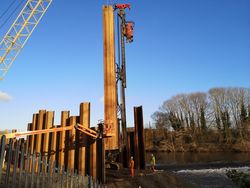Unlocking the Severn
You might not have heard of the humble Shad, but this little fish has played a big part in the history of Worcester.
Until the middle of the 19th century, hundreds of thousands of twaite shad migrated up the River Severn every Spring. Their arrival was welcomed by local people at a time in the year known as the ‘Hungry Gap’, when food supplies might be low. The arrival of the fish provided a ready source of food.
All of that changed when, in Victorian times, a series of weirs were built across the river. These helped to raise and maintain the water level which made it navigable for the boats plying their trade between the Black Country, Worcester and Gloucester Docks. What the weirs also did was to cut off a route along the river to the shad as well as other migratory fish.
Suddenly, the shad couldn’t reach the upper reaches of the river, which they’d used every year to lay their eggs. Although they managed to swim past the the weir at Tewkesbury through a gap, by the time they reached Diglis Weir in Worcester they found their progress blocked.
After more than a century and a half, all of that is about to change. Two years ago, work began to create routes around the Severn’s weirs for migrating fish. Called a fish pass, structures are being built around four weirs that will help the fish and other river wildlife to move up and downstream. Fish passes are often built as a series of ascending pools along the bank, creating steps the fish can swim between.
It's a complicated thing to build and the project on the Severn has involved specialists who work on similar projects worldwide. The fish use the river’s current to find their way upstream and are very sensitive to anything that’s not exactly right. This means the fish pass needs just the right about of flow, without too much turbulence, for them to find their way along. Too many bubbles in the water prevent the shad from seeing each other and so they might lose interest in swimming further.
At Diglis Weir, the new fish pass is a huge structure measuring 100 metres long and 8 metres deep (see photo on page 19). Built in the form of a staircase, it will have ten giant steps and should be opened this autumn.
The result of the new fish passes is what is known as connectivity. Soon, the Severn should be recolonised by species banished by the Victorian engineers, bringing a much greater diversity of wildlife back into the river. Eggs laid by the fish will provide energy and nutrients for insect populations. In turn, these provide food for animals further up the food chain. Once they are born, some of the tiny shad fry will feed other fish, bird and mammal species. Ultimately, all of this helps to improve the richness of biodiversity in and around the river.
As well as the pass at The Diglis, similar projects are happening north of Worcester at Bevere, Holt Fleet and Lincomb near Stourport on Severn.
Within the Diglis fish pass, a viewing window has been included. This will allow visitor groups to literally look under the surface of the river and watch as the fish pass by. Its all part of a wider plan to create a learning space on Diglis Island and reconnect the people of Worcester with the river that’s always run through the heart of the city.
About the Project
The Severn is Britain’s longest river, rising in mid-Wales and flowing southwards to the Bristol Channel. The Unlocking the Severn project takes in a stretch between Shrewsbury and Gloucester with the aim of improving the river as a habitat for aquatic life as well as sparking our interest in the natural and social histories of this stretch of water. The project will restore access to 158 miles of river with important spawning grounds, and its hoped a healthy shad population will become re-established.
It’s a complex project and four partner organisations are involved; The Canal and River Trust, The Severn Rivers Trust, The Environment Agency and Natural England. The work is due to be completed in another year but might be extended as the whole project was held up by February’s floods, followed a month later by the coronavirus pandemic.
What is a twaite shad?
Shad are members of the Clupeidae family of fish which includes all types of herring. They live most of their lives at sea but in May each year they migrate up the River Severn to spawn in gravel beds further up the river. Individual fish live between eight and ten years, during which time they can spawn up to five times.
Before weirs were built across the Severn, hundreds of thousands of fish made the journey every spring, but numbers dwindled dramatically. As a result, the fish is now listed on the Red list of Threatened Rare and endangered fish in the UK by the International Union for the Conservation of Nature.
The current project will help the shad return once more to its historic spawning grounds higher up in the river catchment for the first time in more than 170 years. It’s hoped that by re-opening their breeding grounds in the Severn, the shad population will increase.
Want to find out more?
Saturday 24th October is World Fish Migration Day and activities are planned for the Unlocking the Severn project. Although site visits and face to face activities couldn’t happen during lockdown, its hoped online talks and other events will help the public understand more about the amazing diversity of life in the River Severn and its tributaries.
For more information visit www.unlockingthesevern.co.uk



